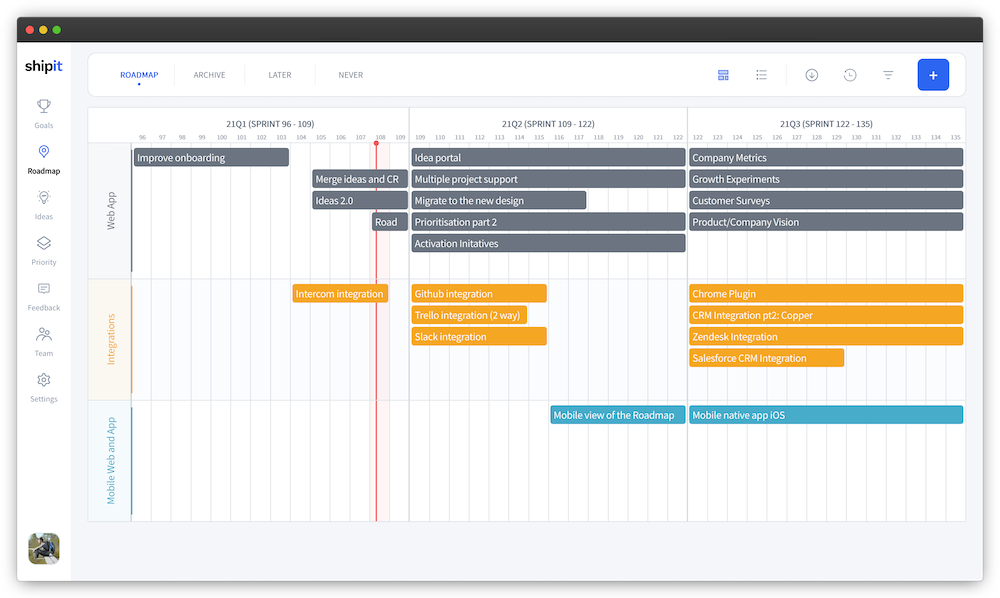Productboard vs shipit
What makes shipit a great alternative to ProductBoard for product management, product roadmaps, idea management and more
ProductBoard is a venture funded company providing software for product management. ProductBoard has been around since 2014. Shipit on the other hand is a nimble player in the field who launched in 2019. Let’s take a look at the differences between the two, and how you might prefer one over the other.

- ProductBoard vs shipit: what are the differences
- ProductBoard vs shipit: what are the similarities
- What makes shipit a great ProductBoard alternative
ProductBoard vs shipit: what are the differences
So what are the main differences between ProductBoard and shipit?
Simple vs complex
ProductBoard is a rather complex tool with lots of features satisfying almost any imagineable approach to product management. You can choose from templates for your roadmap, configure its granularity (weekly, monthly, quarterly), gather feedback from many sources, and perform different types of prioritization (feature-, feedback-, or objective-driven). Adding competitor, company, and product-specific fields, using segment columns can quickly make navigating through the features difficult if you don’t know what to do.
Shipit was built with simplicity in mind. In fact, this is one of our core principles. When you create an account, you can start immidiately without spending a lot of time understanding how the tool works. In fact, one of our early customers was a designer who had to also do product manager’s job in a startup. It is not only the number of features (we cover enough for you to be able to do your job well), but also the simple UI that is easy to navigate.
Instead of covering every possible approach to product management we focus on the most common ones, and the ones that we’ve actually seen work in practice.
Focus on quarterly roadmap and sprint-based execution
We focus on a battle-proven, simple approach with quarterly planning and agile execution. Most development teams use sprints for planning. Instead of planning your roadmap with specific dates, instead we use sprint granularity for planning, which allows you to tie your feature completion with the Agile execution rhytm of your development teams.
Product Requirements Documents
PRDs are essential to product development. These documents allow one to describe feature, requirements, target audience, design and marketing agreements, and help the team quickly understand purpose of the feature. While in ProductBoard it is possible to add generic data to your roadmap items, in shipit PRDs are one of the central parts of the process. We even have integrations with Confluence and Google Docs to generate these with pre-filled values.
Cost
Like many other apps, ProductBoard charges per user. Pricing starts with $20 per seat, and depending on the number of features you choose, you can be charged up to $100 and more for each user. No matter the size of the company, that can become a sizeable amount at the end of the month.
Contrary to a complex structure, shipit has a very simple pricing structure:
- single user account individuals or small companies costs €9/month
- startup account for small companies with up to 3 userscosts €29/month (for the whole company, not per user)
- team account with unlimited number of users costs €49/month (for the whole company, not per user)
The bottom line is that shipit costs you half the money or less, with a set of features that lets you do essentially the same job as ProductBoard.
The Personal plan does not have access to the voting and prioritisation which was built specifically for remote teams to be able to vote and manage roadmap asynchronously.
Venture-funded vs independent
ProductBoard has raised several rounds of investment from large VC companies.
We are a small boutique company with just few people. We are active on IndieHackers getting help and actively helping other small businesses and product developers. Our primary goal is simply make a great, simple-to use tool for product managers and product builders, which satisfies their needs and we also like to use daily ourselves. You can learn more about us.
EU-based
Our company is incorporated in Estonia which is famous for pioneering e-government, e-voting, and supporting its startup ecosystem. Your data is governed by the GDPR which means your data is protected by the law, and you can request its removal any time. We also host it in a European data center.
There is a similar initiative in California, however if your data is located in any other state, you do not have such strong data protection.
ProductBoard vs shipit: what are the similarities
There are a lot of differences between ProductBoard and shipit, but ultimately we’re both aiming to do the same thing: help product managers build their product.
Aligining to company goals using OKRs
When your product roadmap is not dictated by the goals of the company or your department, it might become a big problem along the way. As such, it is important to align product development with the goals. Both shipit and ProductBoard allow you to do that. We make use of quarterly goals (in the form of OKRs) and show you which roadmap items influence which goals, and vice-versa.
Gathering user feedback
Users have a lot of influence on the product development, and their feedback may come in the form of an email, a chat message, a Tweet, or support ticket. Both products allow you to connect different sources and gather this feedback in one place.
What makes shipit a great ProductBoard alternative
Shipit is a simple and user-friendly alternative to ProductBoard built by an independent team. You do not need to have experience as a product manager to start using shipit.
Do you manage a digital product? Give shipit a chance. Sign up for a 14-day unlimited-use free trial with no strings attached, and explore our simple tool for managing your product.
Get our stories about product management delivered
From us to your inbox.